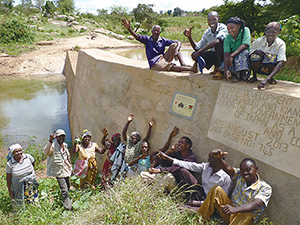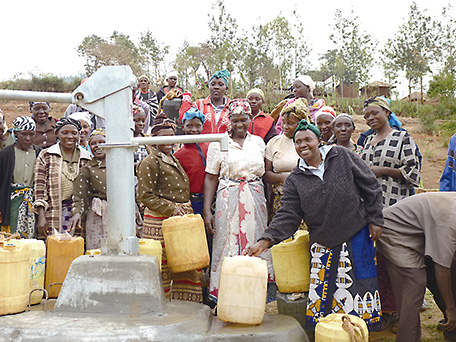Stories from the field 02
Building a dam to ensure a stable supply of water through community involvement
– Grass-roots assistance for the construction of a sand dam in Makueni County, Kenya

Local residents gathering in front of a sand dam. (Photo: Caroline Vigot / Embassy of Japan in Kenya)
Approximately 80% of Kenya's territory is covered by arid or semi-arid land. Makueni County is a semi-arid region located to the southeast of Kenya's capital, Nairobi. The region suffers from chronic water shortages because its water source is chiefly composed of seasonal rivers that appear only during the rainy season. The two areas plagued by the most dire water shortages are Nziu and Emali. The frequency of droughts has been steadily rising over the past 50 years, leaving these regions' main river dried up most of the year except for the rainy season. The water shortages have also caused crop yields to decline in these areas, where the majority of residents work in the agricultural sector. As a result, many locals have been forced to depend on food handouts or remittances from family members working away from home because they can no longer earn a living wage from farming.
In the dry season, women are forced to spend the majority of their days traveling far distances just to collect water. Day after day, they must walk to areas around 5 kilometers away and return home with large containers full of water balanced on their heads. Small children act as helpers and share the burden of gathering water.
In order to address this situation, Japan's Grant Assistance for Grass-Roots Human Security Projects1 was extended to a project that took place between February 2013 and July 2014 in the regions of Nziu and Emali. The project aimed to improve the lives of local residents and alleviate poverty by building five sand dams to ensure a stable supply of water to local residents. Mr. Kevin Muneene, Chief Executive Officer of the Utooni Development Organization (UDO), which implemented this project, explained the concept of the sand dams.
“Sand dams are concrete walls built on rivers that only see large amounts of water during the rainy season. A rapid flow of water and sand hits the concrete walls and creates a sedimentary layer of soil containing sand and water on the upstream side of the wall. Even during the dry season, this sedimentary layer retains water and protects against evaporation while storing a large amount of water (about 40% of the layer). Shovel just 30-50 centimeters into the sand, and water will ooze out, allowing for the easy access to clean, sand-filtered water. Sand dams can be constructed at a low cost, and need almost no maintenance. They are a powerful means to resolve water shortages in arid and semi-arid areas.”
First, at the start of the project, the project team asked locals about their opinions on where the dams should be built, and selected five sites. The construction of the sand dams was carried out by local residents, with the UDO providing technical guidance and worksite supervision. On work days, the staff instructed locals on such matters as the flow of work and the mixing proportions for the concrete. To build one sand dam, about 50 to 60 people participated in the project. The group included a wide variety of people, from women and retired men to students. All of them worked hard to carry out their tasks.

Local residents pumping water into their tanks. (Photo: Embassy of Japan in Kenya)
The project moved forward in this way, with the participation of the local community, in order to build the dams and shallow wells from which to collect water from the dam. However, the project also faced challenges. Mr. Muneene explained, “When building the sand dam, we needed to dig a hole six meters deep from which to scoop out water. It was difficult to bring in construction materials during the rainy season, causing work schedule delays.” When the sand dam was finally finished, the participants shared in the joy of seeing water come out for the first time as the handle of the hand pump to the well was pushed down.
The water from the finished sand dam is being used for drinking and daily life, as well as for raising livestock and agriculture. One local resident said, “Since there is now a stable supply of water, we can live healthily – and not only we, but our cows are gaining weight too!” The lives of women who previously spent most of their days gathering water have also improved greatly, as they are now able to relax or watch over children in their free time, or tend the fruit trees that they grow as food and income sources, and so on.
Mr. Muneene commented, “It was great that the people of the region were able to come together for the common good. Men, women, and the youth worked together towards the same goal. I think we were able to complete the work in a comparatively short time because everyone worked efficiently with a good understanding of what they needed to do. It was an excellent learning opportunity for youth in particular. With the support of Japan, we were able to carry out a valuable project that gave us a sustainable solution to our region's water scarcity issue. The locals who gained knowledge and experience of this project may someday cooperate for the construction and maintenance of sand dams in other areas. The success of this project has been extremely significant for the future development of our entire region.”
*1 Assistance is provided mainly by Japan's diplomatic missions abroad, which are familiar with the situations of each country, for comparatively small-scale projects (In principle, projects requiring less than ¥10 million) to be carried out by the local governments or educational/medical institutions of the developing country or international and local NGOs active in the country.
<< Previous Page Next Page >>
Main Text | Statictics and Reference Materials | Stories from the field | Master Techniques, From Japan to the World - | ODA Topics
